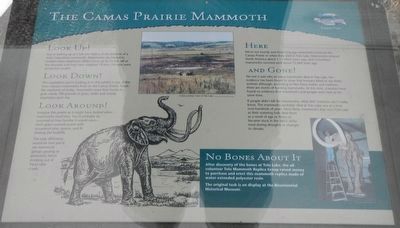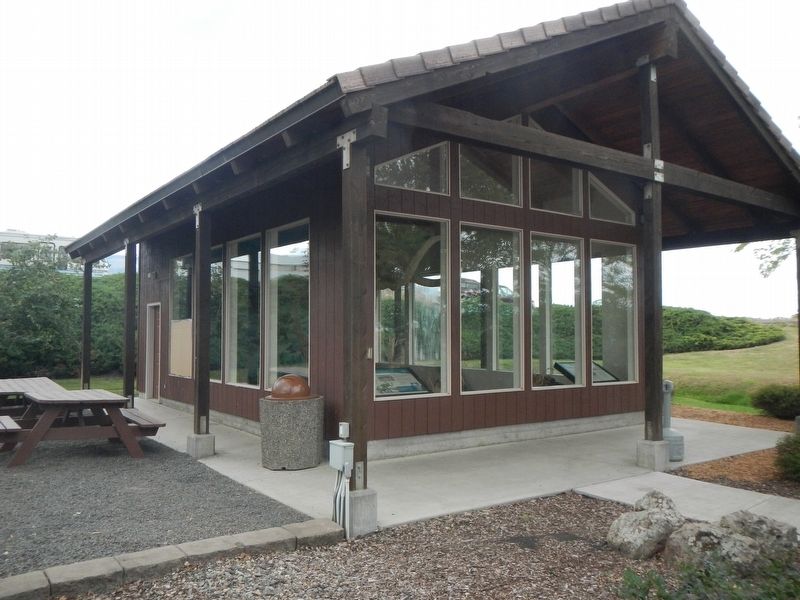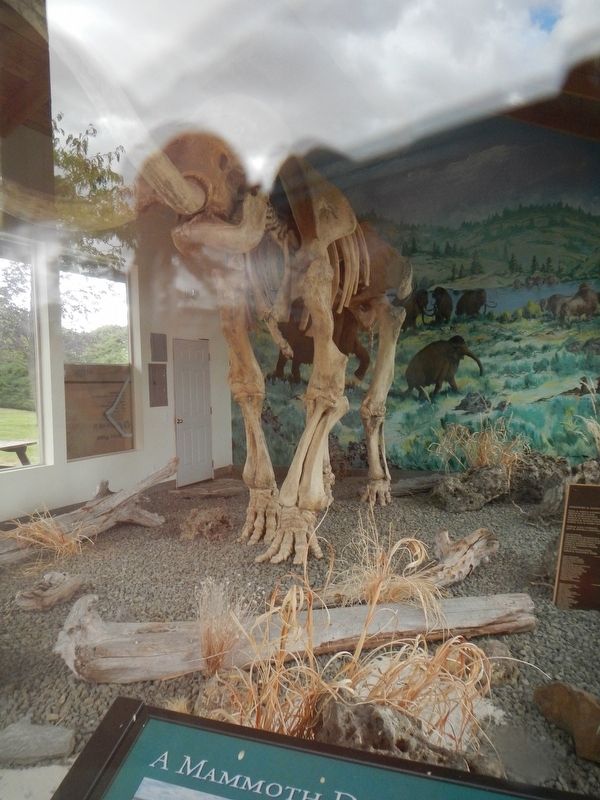Grangeville in Idaho County, Idaho — The American West (Mountains)
The Camas Prairie Mammoth
You're looking up at a full-size replica of the skeleton of a male Columbian mammoth. Mammoths are related to modern Asian elephants. Males stood up to 14 feet tall at the shoulders and may have weighed 10 tons. Females were somewhat smaller.
Look Down!
The vegetation you're looking at in this exhibit is one of the main reasons mammoths lived on the Camas Prairie. Much like elephants of today, mammoths used their trunks to grab nearly 700 pounds of grass, herbs and woody vegetation each day.
Look Around!
Imagine this prairie as it might have looked when mammoths lived here. You'd probably be surprised as how familiar it would seem - short grass-covered prairie with occasional pine, spruce, and fir dotting the foothills.
The only difference would be that you'd see mammoth groups grazing or prehistoric bison drinking out of Three Mile Creek
Here
We're not exactly sure how long ago mammoths live on the Camas Prairie or when they died in Tolo Lake. Mammoths entered North America about 1.5 million years ago, and Columbian mammoths survived until about 12,000 years ago.
and Gone!
No one is sure why so many mammoths died in Tolo Lake. No evidence has been found that humans killed or ate these animals although, according to Nez Perce Indian oral tradition, there are stories of hunting mammoths. At this time, scientists have found no evidence that mammoths and people were here at the same time.
If people didn't kill the mammoths, what did? Scientists don't really know. The mammoths probably died at Tolo Lake one at a time over hundreds of years. Most likely, mammoths that used Tolo Lake as their watering hole died there as a result of age or illness or became stuck in the lake's sticky mud during droughts or changes in climate.
No Bones About It
After discovery of the bones at Tolo Lake, the all volunteer Tolo Mammoth Replica Group raised money to purchase and erect this mammoth replica made of water-extended polyester resin.
The original tusk is on display at the Bicentennial Historical Museum.
Erected by Northwest Passage Scenic Byway and All-American Road.
Topics. This historical marker is listed in this topic list: Paleontology. A significant historical date for this entry is September 4, 1994.
Location. 45° 55.926′ N, 116° 7.912′ W. Marker is in Grangeville, Idaho, in Idaho County. Marker is on Pine Street near U.S. 95, on the right when traveling south. Touch for map. Marker is at or near this postal address: 612 Pine Street, Kooskia ID 83539, United States of America. Touch for directions.
Other nearby markers. At least 8 other markers are within 3 miles of this marker, measured as the crow flies. A Mammoth Discovery (here, next to this marker);
Home on the Grange (here, next to this marker); Gold Pans and Whipsaws (a few steps from this marker); The Camas Connection (a few steps from this marker); The Eimers Legacy (a few steps from this marker); Tolo, Alab-lemot (within shouting distance of this marker); The ADVANCE Steam Traction Engine (approx. half a mile away); Mount Idaho (approx. 3.1 miles away). Touch for a list and map of all markers in Grangeville.
More about this marker. This exhibit is in Eimers Park.
Also see . . . Mammuthus columbi (Columbian mammoth). Wikipedia entry:
Mammuthus columbi is better known as the Columbian mammoth, although it is not actually named after the country Colombia that is in South America, but after the province of British Columbia in Canada. The Columbian mammoth appears to have been one of the most common mammoths roaming North America during the Pleistocene, and is thought to have come from mammoths that crossed the Bering land bridge from Asia into North America during the early Pleistocene at the latest.
(Submitted on October 20, 2019, by Barry Swackhamer of Brentwood, California.)
Credits. This page was last revised on April 28, 2024. It was originally submitted on October 20, 2019, by Barry Swackhamer of Brentwood, California. This page has been viewed 397 times since then and 58 times this year. Photos: 1, 2, 3. submitted on October 20, 2019, by Barry Swackhamer of Brentwood, California.


